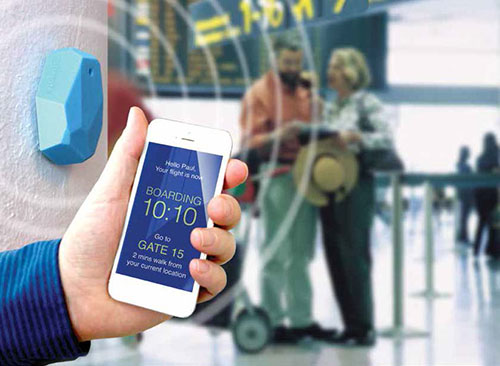Beacons Offer Bridge to Common Goal of Customer Service
 Beacon technology is nothing new, but the way it is being implemented at airports certainly is. Phil Easter, director of mobile apps at American Airlines, says that beacons build a bridge between the airport authority and the airlines by providing information that benefits both, and, most importantly, benefits their common customers, the passengers.
Beacon technology is nothing new, but the way it is being implemented at airports certainly is. Phil Easter, director of mobile apps at American Airlines, says that beacons build a bridge between the airport authority and the airlines by providing information that benefits both, and, most importantly, benefits their common customers, the passengers.
American is currently piloting a beacon mobile application at Dallas/Fort Worth International Airport (DFW). "It brings a lot of information together, but makes it simple to consume the information," says Easter.
The pilot is taking place in Terminal D, and includes more than 100 installed beacons. The beacon app alerts passengers when they have entered Terminal D and then again, when they are near their gates. "Terminals are massive, and people get turned around," Easter explains, noting that 65% of American's DFW customers go directly to their gates for that very reason.
  factsfigures factsfiguresBeacon Technology Project: Beacon Technology Pilot Projects Location: Dallas/Fort Worth Int'l Partner: American Airlines Scope: 100+ beacons within Terminal D Beacon Supplier: Bluvision Technology: Apple's iBeacon Location: Miami Int'l Airport Scope: 246 beacons throughout entire facility Beacon Supplier: Bluvision Installed By: SITA Shared Technology: SITA Common-Use Beacon Registry Of Note: World's first complete & open beacon deployment |
Maurice Jenkins, Miami International Airport's (MIA) division director of information systems agrees that getting from Point A to Point B, and knowing ahead of time how long it will take, are two of the biggest challenges airport passengers face.
That's where the responsiveness of beacon technology really shines, notes Easter. "You can find your location within a second," he explains. "The beacons are easy to deploy, easy to integrate into apps; and based on what we're seeing, we think we'll have a successful rollout."
The airline plans to implement the app at other airports, but is testing multiple aspects at DFW first. "We want to make sure we have the technology, but most importantly, the user experience down in Dallas before we roll it out further," he explains.
The next location may be MIA. Jenkins reports that 246 beacons have been installed by SITA and are ready for applications.
Jenkins first learned about the potential of beacons in June, at the Air Transport IT Summit in Belgium. After listening to an extensive panel discussion and hearing about American's DFW pilot, he says MIA was on board to develop a proof-of-concept for beacons.
The Registry
All the beacons at MIA and DFW are listed on SITA's Common-Use Beacon Registry, a shared infrastructure for SITA members, which include almost all major airlines. Launched in July, the registry is still in its early stages and is open to revisions based on feedback from users, such as those in American's DFW trials, notes Jim Peters, SITA's chief technology officer.

Peters describes the SITA registry as the Yellow Pages for beacons. He explains that all airport beacons will have the same universal identifier, but individual major and minor numbers, indicating concourses and specific locations. This allows any app developer to use the standard beacon IDs, as listed in the registry, to develop individual programs.
"The other alternative would be to have all airlines, all retailers and all facility maintenance people just put up their own beacons; but then you'd have major interference," he notes.
With 246 registered beacons, MIA is the first airport in the world to offer complete and open beacon deployment, note SITA officials. Jenkins highlights two significant factors about the distinction: first, the beacons are placed throughout the entire facility - at every gate, exit point, service area, etc. Second, the registry is not restricted; it is open to applications from developers.
Peters encourages airports considering beacons to contemplate such policy issues before installing them. Interference is a main concern, he explains. Loss of control concerning what data is being spread not to mention how, where and when it is spread are other important factors, he adds.
From the airport perspective, Jenkins acknowledges the long-term benefits of SITA's beacon registry - for passengers and airports alike. Overall, the new technology is a learning process for everyone, he adds.
"We hope that people come to embrace it, challenge themselves and develop apps," Jenkins comments. "We're excited to see what the results look like, so we can start measuring and reporting to the industry over the next year."
The Hardware
Bluvision (previously StickNFind) supplied the beacons installed at MIA and DFW. The beacons use Bluetooth technology to wirelessly emit a beacon identifier (unique to each device) that provides specific information an application is designed to provide, explains Jimmy Buchheim, the company's chief executive officer.
The signals can be set to respond at a wide variety of distances, he notes. For example, an airport might want a beacon to activate when passengers are within one foot of a TSA screening, so an application could trigger their electronic boarding passes to open automatically as they approach the checkpoint. Once the Beacon Registry identifiers are defined and the beacons are searching for those identifiers, a passenger's mobile device "wakes up" automatically, explains Buchheim.
American Airlines is using Apple's iBeacon technology for its pilot at DFW, but the app will support both iBeacon and Android beacon technologies when fully launched, notes Easter.
Return on Investment
Ken Buchanan, executive vice president of revenue management at DFW, reports that the beacons being tested in Terminal D have been good business. "The program is providing a positive and more personalized experience that will inspire passengers to come back to DFW Airport," he reports.
Despite the exciting potential of beacons for airports and airlines alike, Jenkins emphasizes the importance of passengers opting to using them. "If a customer goes to DFW and doesn't have the American Airlines app downloaded, there's nothing we can do as far as beacons," he explains. "The beacons have to be integrated within the application."
Easter acknowledges that some passengers will be concerned about the "Big Brother" aspect of airports using beacons to track them. "That's not the case," he says. "For example, Starbucks can't send you a notice to buy coffee unless you have their app and it's part of that Beacon Registry."
Buchheim offers an additional assurance by noting that beacons can detect motions of people but not individual characteristics. Conglomerated information, however, is beneficial to airports; it's how MIA is hoping to see back-end deliverables from the beacon installation, he explains.
Whether airports invest directly in beacons and then enroll in the registry, or have SITA install the  beacons, costs are involved. "Someone needs to actually walk the airport with a beacon application that reveals where people have placed rogue beacons," advises Peters. The devices also require batteries and monitoring to ensure they don't get moved or taken.
beacons, costs are involved. "Someone needs to actually walk the airport with a beacon application that reveals where people have placed rogue beacons," advises Peters. The devices also require batteries and monitoring to ensure they don't get moved or taken.
With test projects still in their infancy, the biggest potential return on investment has yet to realized, but is highly anticipated. With a few additional sensors, beacons can be outfitted to gather data such as temperature, light, voice and motion. From controlling heating and air-conditioning in various parts of the terminal to monitoring movement within Baggage Claim, there are many ways beacons can increase efficiencies and, in turn, save airports time and money. If an elevator or escalator remains still for too long, maintenance personnel can be notified sooner rather than later, Buchheim explains.
"That was a trigger factor for me," relates Jenkins, noting that MIA's annual power bill exceeds $20 million. "If we can use these beacons to also regulate temperature and reduce our carbon footprint and power consumption by let's say 5, 10 or 15 percent, we have achieved a two-fold goal."
Although there are many ways to use beacons, Easter encourages airports to initially focus on customer service and navigation applications. "If you lose sight of providing the simple-use cases, you may not be able to deliver on some of the more grandiose things down the road," he advises.
Mobile device applications are becoming very personal, adds Easter, warning that passengers want to know what's available at an airport but not be assaulted with a barrage of coupon offers. "As long as we put the customer first and ask if the beacons stay core to our customer tenets of providing service and enhancing the journey, let's do that," he concludes.
Jenkins agrees, noting that beacons can bring added value to airports and airlines alike, but collaboration is key to achieving the mutual benefits. He stresses that the ideal level of service for passengers should always be the end goal, and beacons can be an effective bridge to it.
|
Internet of Things
Type the phrase "Internet of Things" into any search engine, and you'll have pages and pages of information at your disposal. The concept has been discussed by tech professionals for a number of years, but is now making its way into mainstream conversations. In the early days of the Internet, people manually entered the information that appeared on the World Wide Web. Today, sensors embedded in physical objects, linked through wired and wireless networks, use the same IP protocol as the Internet, and enormous amounts of information are sent through computers for analysis. Those links provide all types of data from ordinary things; and that's what the "Internet of Things" refers to. "All of a sudden, your elevator is a 'thing' ... and your baggage belt ... and your HVAC system," says Jim Peters, chief technology officer at SITA. "Beacons are the core of the Internet of Things, " adds Jimmy Buchheim, chief executive of beacon hardware provider Bluvision. Buchheim predicts that the term "Internet of Things" soon will be as common as the Internet itself. Airports will be able to use information collected by default for a variety of defined purposes, from passenger movement analysis to the revision of business models. Beacons, like those being tested at Miami International and Dallas-Fort Worth International Airport, are the connection that can lead airports directly into the Internet of Things. |
FREE Whitepaper
PAVIX: Proven Winner for All Airport Concrete Infrastructure
International Chem-Crete Corporation (ICC) manufactures and sells PAVIX, a unique line of crystalline waterproofing products that penetrate into the surface of cured concrete to fill and seal pores and capillary voids, creating a long lasting protective zone within the concrete substrate.
Once concrete is treated, water is prevented from penetrating through this protective zone and causing associated damage, such as freeze-thaw cracking, reinforcing steel corrosion, chloride ion penetration, and ASR related cracking.
This white paper discusses how the PAVIX CCC100 technology works and its applications.








